Ulvik Municipality
Ulvik herad | |
|---|---|
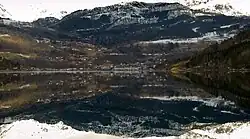 View of the Ulvik area | |
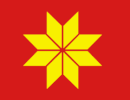 Flag | |
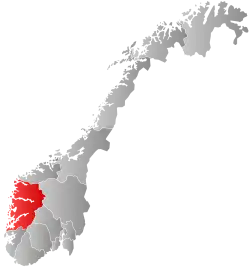 Vestland within Norway | |
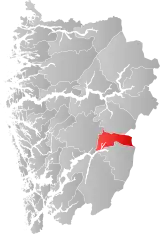 Ulvik within Vestland | |
| Coordinates: 60°37′16″N 07°04′49″E / 60.62111°N 7.08028°E | |
| Country | Norway |
| County | Vestland |
| District | Hardanger |
| Established | 1 Jan 1838 |
| • Created as | Formannskapsdistrikt |
| Administrative centre | Ulvik |
| Government | |
| • Mayor (2011) | Hans Petter Thorbjørnsen (Ap) |
| Area | |
| • Total | 721.99 km2 (278.76 sq mi) |
| • Land | 663.21 km2 (256.07 sq mi) |
| • Water | 58.78 km2 (22.70 sq mi) 8.1% |
| • Rank | #158 in Norway |
| Population (2022) | |
| • Total | 1,051 |
| • Rank | #331 in Norway |
| • Density | 1.6/km2 (4/sq mi) |
| • Change (10 years) | |
| Demonym | Ulvikje[1] |
| Official language | |
| • Norwegian form | Nynorsk |
| Time zone | UTC+01:00 (CET) |
| • Summer (DST) | UTC+02:00 (CEST) |
| ISO 3166 code | NO-4620[3] |
| Website | Official website |
Ulvik is a municipality in Vestland county, Norway. The municipality stretches from the Hardangerfjord to the mountains that reach 1,800 metres (5,900 ft) above sea level. The administrative centre of the municipality is the village of Ulvik. The villages of Osa and Finse are also located in Ulvik municipality.
The 722-square-kilometre (279 sq mi) municipality is the 158th largest by area out of the 356 municipalities in Norway. Ulvik is the 331st most populous municipality in Norway with a population of 1,051. The municipality's population density is 1.6 inhabitants per square kilometre (4.1/sq mi) and its population has decreased by 5.5% over the previous 10-year period.[4][5] Of the municipality's total population, nearly half live in the village of Ulvik at the end of the Ulvikafjorden. The vast majority of those who do not live in the village of Ulvik live on the farms surrounding the village or at the end of the Osa Fjord in the village of Osa.
In 2016, the chief of police for Vestlandet formally suggested a reconfiguration of police districts and stations. He proposed that the police station in Ulvik be closed.[6]
General information




The parish of Graven (later spelled "Granvin") was established as a municipality on 1 January 1838 (see formannskapsdistrikt law). This large municipality/parish included two annexes: Ulvik and Eidfjord. On 1 January 1859, Ulvik became the main parish, making Graven and Eidfjord annexes to Ulvik, and the name of the large municipality was changed from Graven to Ulvik.[7]
On 1 May 1891, the western annex of Graven (population: 1,331) and the southeastern annex of Eidfjord (population: 1,018) were separated from Ulvik to become separate municipalities. This left Ulvik with a much smaller size and 1,410 residents. In 1895, a small area of Eidfjord (population: 3) was transferred to Ulvik.[7]
Name
The municipality (originally the parish) is named after the old Ulvik farm (Old Norse: Ulfvík) since the first Ulvik Church was built there. The first element is ulfr which means "wolf". The last element is vík which means "bay", "cove, or "wick".[8][9]
Coat of arms
The coat of arms was granted on 19 December 1986. The official blazon is "Gules, eight lozenges in annulet Or" (Norwegian: På raud grunn åtte gule spissruter i rosett). This means the arms have a red field (background) and the charge is a set of eight lozenges arranged around a point, making a symmetrical rosette design. The charge has a tincture of Or which means it is commonly colored yellow, but if it is made out of metal, then gold is used. The figure is a traditional design seen in the local folk-art and in local textiles (including in the bunad of Ulvik). The pattern can be traced in local arts as far back as the 16th century, and is similar to the selburose. The arms were designed by Stein Davidsen. The municipal flag has the same design as the coat of arms.[10][11][12]
Churches
The Church of Norway has one parish (sokn) within the municipality of Ulvik. It is part of the Hardanger og Voss prosti (deanery) in the Diocese of Bjørgvin.
| Parish (sokn) | Church name | Location of the church | Year built |
|---|---|---|---|
| Ulvik | Ulvik Church | Ulvik | 1859 |
Geography

The municipality is situated around the Hardangerfjord's northeastern arms: the Osa Fjord and Ulvikafjorden, extending far into the Hardangervidda plateau. The northernmost part of the Hardangerjøkulen glacier is in Ulvik. The Finse and Hallingskeid areas lie just south of the Hallingskarvet National Park which partially sits inside Ulvik and includes the Hallingskarvet mountains. The municipality of Ulvik borders the municipalities of Eidfjord, Ullensvang, Voss, Aurland, and Hol. Lakes in the region include Finsevatnet and Flakavatnet. The headwaters of the Flåmselvi river also lie in Ulvik.
History
After the dissolution of the union between Sweden and Norway in 1905, Ulvik was one of the few municipalities that returned a majority in favour of a republic rather than a monarchy in the national referendum on the issue.
The village of Ulvik was nearly totally destroyed on 25 April 1940, during the German invasion of Norway, when fighting erupted between a German landing party arriving in boats, and a Norwegian force on land. Most of the village was burned down, and three civilians were killed. An unknown number of German soldiers were also killed in the fighting.
Population
|
|
| |||||||||||||||||||||||||||||||||||||||||||||||||||||||||||||||
| Note: The municipal borders were changed in 1891, causing a significant change in the population. Source: Statistics Norway[13][14] and Norwegian Historical Data Centre[15] | |||||||||||||||||||||||||||||||||||||||||||||||||||||||||||||||||
Government
All municipalities in Norway are responsible for primary education (through 10th grade), outpatient health services, senior citizen services, welfare and other social services, zoning, economic development, and municipal roads and utilities. The municipality is governed by a municipal council of directly elected representatives. The mayor is indirectly elected by a vote of the municipal council.[16] The municipality falls under the Hordaland District Court and the Gulating Court of Appeal.
Municipal council
The municipal council (Heradsstyre) of Ulvik is made up of 17 representatives that are elected to four year terms. The party breakdown of the council is as follows:
| Party name (in Nynorsk) | Number of representatives | |
|---|---|---|
| Labour Party (Arbeidarpartiet) | 5 | |
| Conservative Party (Høgre) | 2 | |
| Centre Party (Senterpartiet) | 5 | |
| Socialist Left Party (Sosialistisk Venstreparti) | 2 | |
| Liberal Party (Venstre) | 3 | |
| Total number of members: | 17 | |
| Party name (in Nynorsk) | Number of representatives | |
|---|---|---|
| Labour Party (Arbeidarpartiet) | 5 | |
| Conservative Party (Høgre) | 2 | |
| Centre Party (Senterpartiet) | 4 | |
| Socialist Left Party (Sosialistisk Venstreparti) | 2 | |
| Liberal Party (Venstre) | 4 | |
| Total number of members: | 17 | |
| Party name (in Nynorsk) | Number of representatives | |
|---|---|---|
| Labour Party (Arbeidarpartiet) | 3 | |
| Conservative Party (Høgre) | 3 | |
| Centre Party (Senterpartiet) | 3 | |
| Socialist Left Party (Sosialistisk Venstreparti) | 2 | |
| Liberal Party (Venstre) | 6 | |
| Total number of members: | 17 | |
| Party name (in Nynorsk) | Number of representatives | |
|---|---|---|
| Labour Party (Arbeidarpartiet) | 2 | |
| Conservative Party (Høgre) | 1 | |
| Centre Party (Senterpartiet) | 4 | |
| Socialist Left Party (Sosialistisk Venstreparti) | 3 | |
| Liberal Party (Venstre) | 6 | |
| Local list (Bygdelista) | 1 | |
| Total number of members: | 17 | |
| Party name (in Nynorsk) | Number of representatives | |
|---|---|---|
| Labour Party (Arbeidarpartiet) | 3 | |
| Conservative Party (Høgre) | 1 | |
| The Democrats (Demokratane) | 1 | |
| Centre Party (Senterpartiet) | 5 | |
| Socialist Left Party (Sosialistisk Venstreparti) | 3 | |
| Liberal Party (Venstre) | 4 | |
| Total number of members: | 17 | |
| Party name (in Nynorsk) | Number of representatives | |
|---|---|---|
| Labour Party (Arbeidarpartiet) | 3 | |
| Progress Party (Framstegspartiet) | 1 | |
| Conservative Party (Høgre) | 1 | |
| Centre Party (Senterpartiet) | 5 | |
| Socialist Left Party (Sosialistisk Venstreparti) | 1 | |
| Liberal Party (Venstre) | 6 | |
| Total number of members: | 17 | |
| Party name (in Nynorsk) | Number of representatives | |
|---|---|---|
| Labour Party (Arbeidarpartiet) | 2 | |
| Conservative Party (Høgre) | 1 | |
| Centre Party (Senterpartiet) | 7 | |
| Socialist Left Party (Sosialistisk Venstreparti) | 1 | |
| Liberal Party (Venstre) | 6 | |
| Total number of members: | 17 | |
| Party name (in Nynorsk) | Number of representatives | |
|---|---|---|
| Labour Party (Arbeidarpartiet) | 4 | |
| Conservative Party (Høgre) | 2 | |
| Centre Party (Senterpartiet) | 7 | |
| Socialist Left Party (Sosialistisk Venstreparti) | 2 | |
| Liberal Party (Venstre) | 2 | |
| Total number of members: | 17 | |
| Party name (in Nynorsk) | Number of representatives | |
|---|---|---|
| Labour Party (Arbeidarpartiet) | 5 | |
| Conservative Party (Høgre) | 2 | |
| Centre Party (Senterpartiet) | 6 | |
| Socialist Left Party (Sosialistisk Venstreparti) | 1 | |
| Liberal Party (Venstre) | 3 | |
| Total number of members: | 17 | |
| Party name (in Nynorsk) | Number of representatives | |
|---|---|---|
| Labour Party (Arbeidarpartiet) | 6 | |
| Conservative Party (Høgre) | 2 | |
| Centre Party (Senterpartiet) | 5 | |
| Liberal Party (Venstre) | 4 | |
| Total number of members: | 17 | |
| Party name (in Nynorsk) | Number of representatives | |
|---|---|---|
| Labour Party (Arbeidarpartiet) | 6 | |
| Conservative Party (Høgre) | 3 | |
| Centre Party (Senterpartiet) | 6 | |
| Liberal Party (Venstre) | 2 | |
| Total number of members: | 17 | |
| Party name (in Nynorsk) | Number of representatives | |
|---|---|---|
| Labour Party (Arbeidarpartiet) | 5 | |
| Conservative Party (Høgre) | 2 | |
| Centre Party (Senterpartiet) | 7 | |
| Joint list of the Christian Democratic Party (Kristeleg Folkeparti), New People's Party (Nye Folkepartiet), and Liberal Party (Venstre) | 3 | |
| Total number of members: | 17 | |
| Party name (in Nynorsk) | Number of representatives | |
|---|---|---|
| Labour Party (Arbeidarpartiet) | 6 | |
| Conservative Party (Høgre) | 1 | |
| Centre Party (Senterpartiet) | 7 | |
| Liberal Party (Venstre) | 3 | |
| Total number of members: | 17 | |
| Party name (in Nynorsk) | Number of representatives | |
|---|---|---|
| Labour Party (Arbeidarpartiet) | 5 | |
| Conservative Party (Høgre) | 2 | |
| Centre Party (Senterpartiet) | 4 | |
| Liberal Party (Venstre) | 4 | |
| Joint List(s) of Non-Socialist Parties (Borgarlege Felleslister) | 2 | |
| Total number of members: | 17 | |
| Party name (in Nynorsk) | Number of representatives | |
|---|---|---|
| Labour Party (Arbeidarpartiet) | 6 | |
| Conservative Party (Høgre) | 2 | |
| Centre Party (Senterpartiet) | 5 | |
| Liberal Party (Venstre) | 4 | |
| Total number of members: | 17 | |
| Party name (in Nynorsk) | Number of representatives | |
|---|---|---|
| Labour Party (Arbeidarpartiet) | 6 | |
| Conservative Party (Høgre) | 2 | |
| Centre Party (Senterpartiet) | 6 | |
| Liberal Party (Venstre) | 3 | |
| Total number of members: | 17 | |
| Party name (in Nynorsk) | Number of representatives | |
|---|---|---|
| Labour Party (Arbeidarpartiet) | 6 | |
| Conservative Party (Høgre) | 1 | |
| Farmers' Party (Bondepartiet) | 5 | |
| Liberal Party (Venstre) | 5 | |
| Total number of members: | 17 | |
| Party name (in Nynorsk) | Number of representatives | |
|---|---|---|
| Labour Party (Arbeidarpartiet) | 6 | |
| Liberal Party (Venstre) | 5 | |
| Joint List(s) of Non-Socialist Parties (Borgarlege Felleslister) | 5 | |
| Total number of members: | 16 | |
| Party name (in Nynorsk) | Number of representatives | |
|---|---|---|
| Labour Party (Arbeidarpartiet) | 6 | |
| Liberal Party (Venstre) | 4 | |
| Joint List(s) of Non-Socialist Parties (Borgarlege Felleslister) | 6 | |
| Total number of members: | 16 | |
| Party name (in Nynorsk) | Number of representatives | |
|---|---|---|
| Labour Party (Arbeidarpartiet) | 7 | |
| Local List(s) (Lokale lister) | 9 | |
| Total number of members: | 16 | |
| Party name (in Nynorsk) | Number of representatives | |
|---|---|---|
| Labour Party (Arbeidarpartiet) | 6 | |
| Liberal Party (Venstre) | 6 | |
| Joint List(s) of Non-Socialist Parties (Borgarlege Felleslister) | 4 | |
| Total number of members: | 16 | |
| Note: Due to the German occupation of Norway during World War II, no elections were held for new municipal councils until after the war ended in 1945. | ||
Mayors
The mayors of Ulvik (incomplete list):
- 1876–1888: Hans Larsen Saakvitne
- 1890–1891: Hans Larsen Saakvitne
- 1987–1991: Lars Sponheim (V)
- 1991–1995: Ragnvald Fleten (Sp)
- 1995–2001: Terje Breivik (V)
- 2001–2007: Jon Olav Heggseth (Sp)
- 2007–2011: Mona Haugland Hellesnes (V)
- 2011–present: Hans Petter Thorbjørnsen (Ap)
Transportation
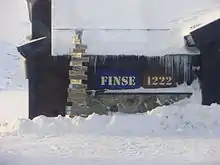
It takes around two hours to drive from the city of Bergen to Ulvik via the European route E16 highway to Vossevangen and then taking Norwegian National Road 13 through the Vallavik Tunnel to Ulvik. The Norwegian National Road 13 continues through Ulvik before crossing the Hardanger Bridge which goes over the Hardangerfjord. The nearest airport is Bergen Flesland Airport in Bergen.
The Bergen Line runs through the northern part of Ulvik. It runs through a region that has no road access, but is a popular with hiking and sports enthusiasts. The railway station at Finse on the Bergen Line at an elevation of 1,222 metres (4,009 ft) is the highest station on the Norwegian railway system. The Finse Tunnel just outside Finse is one of the longest railway tunnels in Norway. The Rallarvegen "road" is an historic road that follows the Bergen Line through Ulvik. It is a popular biking and hiking route. Ulvik is also visited in the summer by numerous foreign cruise ships who travel along the fjord.
Notable people
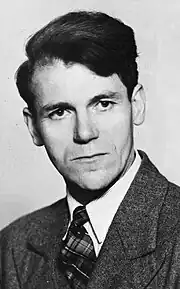
- Catharine Hermine Kølle (1788–1859), a Norwegian adventurer, writer and artist; lived in Ulvik from 1807
- Lars Osa (1860 in Ulvik – 1958), an artist who worked on church restorations; noted fiddle player
- Olav H. Hauge (1908 in Ulvik – 1994), a Norwegian horticulturist, translator and poet
- Sigbjørn Bernhoft Osa (1910 in Ulvik – 1990), a Norwegian fiddler and traditional folk musician
- Gunnar Hjeltnes (1922 in Ulvik – 2013), an alpine skier, competed at the 1952 Winter Olympics
- Lars Sponheim (born 1957), a politician who was County Governor of Vestland and Mayor of Ulvik from 1988-1991
- Terje Breivik (born 1965), a Norwegian politician and entrepreneur who was Mayor of Ulvik from 1995-2001
References
- ↑ "Navn på steder og personer: Innbyggjarnamn" (in Norwegian). Språkrådet.
- ↑ "Forskrift om målvedtak i kommunar og fylkeskommunar" (in Norwegian). Lovdata.no.
- ↑ Bolstad, Erik; Thorsnæs, Geir, eds. (26 January 2023). "Kommunenummer". Store norske leksikon (in Norwegian). Kunnskapsforlaget.
- ↑ Statistisk sentralbyrå. "Table: 06913: Population 1 January and population changes during the calendar year (M)" (in Norwegian).
- ↑ Statistisk sentralbyrå. "09280: Area of land and fresh water (km²) (M)" (in Norwegian).
- ↑ Fjelltveit, Ingvild; Raunholm, Per Vidar (20 December 2016). "Foreslår å legge ned 17 lensmannskontor i Vest politidistrikt". NRK Hordaland (in Norwegian). Retrieved 20 October 2017.
- 1 2 Jukvam, Dag (1999). Historisk oversikt over endringer i kommune- og fylkesinndelingen (PDF) (in Norwegian). Statistisk sentralbyrå. ISBN 9788253746845.
- ↑ Brekke, Nils Georg; Skaar, Ronny B.; Nord, Svein (1993). Kulturhistorisk Vegbok Hordaland (in Norwegian). Nord4.
- ↑ Rygh, Oluf (1910). Norske gaardnavne: Søndre Bergenhus amt (in Norwegian) (11 ed.). Kristiania, Norge: W. C. Fabritius & sønners bogtrikkeri. p. 475.
- ↑ "Civic heraldry of Norway - Norske Kommunevåpen". Heraldry of the World. Retrieved 20 May 2023.
- ↑ "Ulvik, Hordaland (Norway)". Flags of the World. Retrieved 20 May 2023.
- ↑ "Godkjenning av våpen og flagg". Lovdata.no (in Norwegian). Norges kommunal- og arbeidsdepartementet. 19 December 1986. Retrieved 20 May 2023.
- ↑ Statistisk sentralbyrå. "Table: 06913: Population 1 January and population changes during the calendar year (M)" (in Norwegian).
- ↑ Statistisk sentralbyrå. "Folketellingen 1960" (PDF) (in Norwegian).
- ↑ Universitetet i Tromsø – Norges arktiske universitet. "Censuses in the Norwegian Historical Data Archive (NHDC)".
- ↑ Hansen, Tore; Vabo, Signy Irene, eds. (20 September 2022). "kommunestyre". Store norske leksikon (in Norwegian). Kunnskapsforlaget. Retrieved 14 October 2022.
- ↑ "Tall for Norge: Kommunestyrevalg 2019 - Vestland". Valg Direktoratet. Retrieved 2 February 2020.
- 1 2 3 4 "Table: 04813: Members of the local councils, by party/electoral list at the Municipal Council election (M)" (in Norwegian). Statistics Norway.
- ↑ "Tall for Norge: Kommunestyrevalg 2011 - Hordaland". Valg Direktoratet. Retrieved 2 February 2020.
- ↑ "Kommunestyrevalget 1995" (PDF) (in Norwegian). Oslo-Kongsvinger: Statistisk sentralbyrå. 1996. Retrieved 20 February 2020.
- ↑ "Kommunestyrevalget 1991" (PDF) (in Norwegian). Oslo-Kongsvinger: Statistisk sentralbyrå. 1993. Retrieved 20 February 2020.
- ↑ "Kommunestyrevalget 1987" (PDF) (in Norwegian). Oslo-Kongsvinger: Statistisk sentralbyrå. 1988. Retrieved 20 February 2020.
- ↑ "Kommunestyrevalget 1983" (PDF) (in Norwegian). Oslo-Kongsvinger: Statistisk sentralbyrå. 1984. Retrieved 20 February 2020.
- ↑ "Kommunestyrevalget 1979" (PDF) (in Norwegian). Oslo: Statistisk sentralbyrå. 1979. Retrieved 20 February 2020.
- ↑ "Kommunevalgene 1975" (PDF) (in Norwegian). Oslo: Statistisk sentralbyrå. 1977. Retrieved 10 May 2020.
- ↑ "Kommunevalgene 1972" (PDF) (in Norwegian). Oslo: Statistisk sentralbyrå. 1973. Retrieved 10 May 2020.
- ↑ "Kommunevalgene 1967" (PDF) (in Norwegian). Oslo: Statistisk sentralbyrå. 1967. Retrieved 10 May 2020.
- ↑ "Kommunevalgene 1963" (PDF) (in Norwegian). Oslo: Statistisk sentralbyrå. 1964. Retrieved 10 May 2020.
- ↑ "Kommunevalgene og Ordførervalgene 1959" (PDF) (in Norwegian). Oslo: Statistisk sentralbyrå. 1960. Retrieved 10 May 2020.
- ↑ "Kommunevalgene og Ordførervalgene 1955" (PDF) (in Norwegian). Oslo: Statistisk sentralbyrå. 1957. Retrieved 10 May 2020.
- ↑ "Kommunevalgene og Ordførervalgene 1951" (PDF) (in Norwegian). Oslo: Statistisk sentralbyrå. 1952. Retrieved 10 May 2020.
- ↑ "Kommunevalgene og Ordførervalgene 1947" (PDF) (in Norwegian). Oslo: Statistisk sentralbyrå. 1948. Retrieved 10 May 2020.
- ↑ "Kommunevalgene og Ordførervalgene 1945" (PDF) (in Norwegian). Oslo: Statistisk sentralbyrå. 1947. Retrieved 10 May 2020.
- ↑ "Kommunevalgene og Ordførervalgene 1937" (PDF) (in Norwegian). Oslo: Statistisk sentralbyrå. 1938. Retrieved 10 May 2020.
External links
 Hordaland travel guide from Wikivoyage
Hordaland travel guide from Wikivoyage Ulvik travel guide from Wikivoyage
Ulvik travel guide from Wikivoyage- Municipal fact sheet from Statistics Norway (in Norwegian)
- Municipality website (in Norwegian)
- Ulvik Tourist Office (available in English/German/Norwegian)

